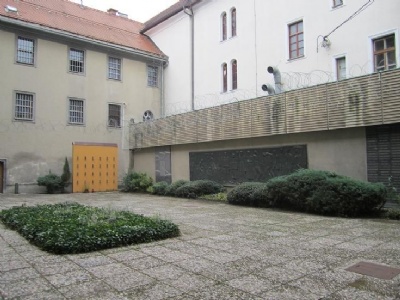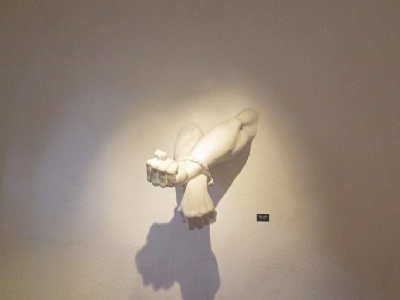Stari Pisker
On April 11, 1941, the Germans occupied the city of Celje, about 50 kilometres east of Ljubljana. As in Eastern Europe, the Germans sought to quickly pacify parts of Slovenia (Untersteiermark) that were occupied and incorporated in Germany. This was a task that fell on Gestapo who arrived in Celje three days after the city was occupied in the company of Heinrich Himmler himself. For Gestapo, it was a matter of quickly finding a suitable prison, and as they usually did, they overtook already existing prisons. In Celje there was a prison in a former monastery called Stari Pisker. When Germany occupied the city there were about 200 prisoners in the prison. Most of these were released, but the serious criminals were transferred to a prison in Graz (now Austria). Gestapo imprisoned intellectuals and educated people and in May there were about 700 Slovenian nationalists in prison.
The prison was divided in four sections, three for male prisoners and one for female prisoners. Initially, conditions were acceptable, but as Slovenian resistance increased, so did the number of prisoners. Gestapo’s treatment of prisoners also intensified and sharpened. The Gestapo used both maltreatment and torture during interrogation to extort confessions or concessions from prisoners. Sometimes prisoners died during interrogation. In September 1941, the first executions of ”political criminals” were carried out in Stari Pisker’s courtyard. Until August 1942, six summary executions were carried out in which a total of 374 prisoners (325 men and 49 women) were executed. One of these executions was photographed by the Germans and luckily found after the war.
Before execution the condemned were placed in special cells and were allowed to write a farewell letter to love ones. After being executed, the bodies were placed in primitive coffins and taken to a crematorium in Graz and cremated. All executions were publicly announced stating the names of the people about to be executed and the verdict. The executions were approved by the district’s political leader (Gauleiter) Dr. Siegfried Uberreither and SS-Obergruppenführer Erwin Rösener, who was the supreme locale SS leader. Another SS officer with blood on his hands was SS-Standartenführer, Otto Lurker, Supreme head of SIPO and SD in Untersteiermark. By this office he was ultimately responsible for the mass executions of civilians in Slovenia. Both Rösener and Lurker was tried for war crimes after the war in Yugoslavia and sentenced to death by hanging.
By November 1944, partisan units carried out frequent attacks in Slovenia. As a response to these attacks the germans retaliated harshly by shooting prisoners and hostages to deterrent future attacks. This had no effect and the attacks and sabotages continued, but so did the executions of civilians. In December 1944, the resistance (partisans) was told that Gestapo planned to transfer about 80 prisoners to Maribor (german Marburg) for execution. The partisan then staged a bold plan to save them. Six partisans dressed in German uniforms managed to pass the security zones surrounding Celje. With the help of an informant inside the prison they managed to disarm the guards and free over 100 prisoners without a single shot being fired. In May 1945, the prison was liberated by the partisans who in turn began to imprison political prisoners and german collaborators.
Current status: Preserved with museum (2011).
Address: Presernova ulica 20 – 22, 3000 Celje.
Get there: Walk from central Celje.
Follow up in books: Pavlowitch, Steven: Hitler’s New Disorder: The Second World War in Yugoslavia (2008).


The brutality of the Germans in Yugoslavia was just like in Eastern Europe, but what is less known is the brutality that befell the opponents of the communists shortly after the war. In and around Celje, Tito’s partisans murdered about 80,000 people they considered being enemies. At Teharje, just east of Celje, the communists set up a concentration camp in a German former military camp and murdered until the camp was liquidated in 1950, 5,000 people. This brutality that Tito’s partisans/communists perpetrated was not unique to Celje but occurred throughout the former. Yugoslavia, in particular the Croatians had to suffer exceptionally hard. Even today, mass graves are found after executions and the debate around Tito and the years after the war is still a hot topic in former Yugoslavia. How many people were murdered will never be determined because the data differ greatly depending on the source.
Although Yugoslavia is now divided into six independent states (Bosnia-Herzegovina, Croatia, North macedonia, Montenegro, Slovenia and Serbia), there is absolutely no historical consensus on the country’s history. In the case of Tito, he is still a person whose historical heritage is divided. The fact that Tito’s partisans drove the Germans out of Yugoslavia while indiscriminately murdering anti-partisans makes him a complex person. Historians I have spoken to in Slovenia, Croatia and Serbia do not really know how to relate to him. Generally speaking, they see him as a person who did both good and bad things. Good by freeing Yugoslavia from the Germans and that he kept the nationalist feelings in check but after his death in 1980 began to smolder and resulted in several civil wars in the nineties. He was a dictator with blood on his hands.